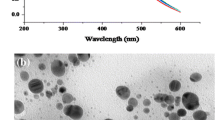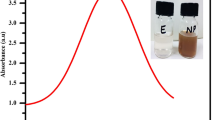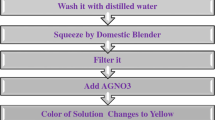Abstract
Myristica fragrans, also known as nutmeg, is a spice that cures various diseases. This study aimed to synthesize silver nanoparticles from a hydroethanolic extract of Myristica fragrans seeds (MFHE) and evaluate their anti-diabetic properties. To MFHE, AgNO3 solution was added and exposed to sunlight to produce silver nanoparticles from hydroethanolic seed extract of Myristica fragrans (MFHENP). The MFHENP was characterized by numerous techniques. UV-visible spectroscopy confirmed the formation of silver nanoparticles by the absorption peak at 430nm. Scanning electron microscopy (SEM) studies revealed the shape and size of the particles at the range of 50–60nm. Energy-dispersive X-ray spectroscopy (EDX) disclosed the presence of silver ions. X-ray diffraction spectrum confirmed the crystalline nature of silver nanoparticles by the peak at 39°. FTIR analysis revealed the functional groups present in MFHE as well as in MFHENP and zeta potential analysis was found to be 14mV. Furthermore, in vitro anti-diabetic activity was investigated. MFHENP showed significant efficiency against the inhibition of alpha-amylase and alpha-glucosidase enzymes and also MFHENP retarded the glucose transport across the membrane which is analyzed by glucose diffusion and glucose uptake assays. Acarbose is used as a standard for all these methods and MFHENP efficiency proves their therapeutic potential for the treatment of diabetes mellitus.





Similar content being viewed by others
References
Bayda, S., Adeel, M., Tuccinardi, T., Cordani, M., & Flavio Rizzolio, F. (2020). The history of nanoscience and nanotechnology: from chemical–physical applications to nanomedicine, molecules, 25, 1–15.
Almatroudi, A. (2020). Silver nanoparticles: synthesis, characterisation and biomedical applications. Open Life Sciences, 15, 819–839. https://doi.org/10.1515/biol-2020-0094
Dawadi, S., Katuwal, S., Gupta, A., Lamichhane, U., Thapa, R., Jaisi, S., Lamichhane, G., Bhattarai, D. P., & Parajuli, N. (2021). Current research on silver nanoparticles: synthesis, characterization, and applications. Journal of nanomaterials, 1–23.
He, Y., Al-Mureish, A., & Wu, N. (2021). Nanotechnology in the treatment of diabetic complications: a comprehensive narrative review. Journal of Diabetes Research, 1–11. https://doi.org/10.1155/2021/6612063
Mikhailova, E. O. (2020). Silver nanoparticles : mechanism of action and probable bio application. Journal of functional biomaterials, 1–26. https://doi.org/10.3390/jfb11040084
Diabetes-overview, symptoms and treatments, World Health Organization, 2021.
Diabetes, World Health Organization, (2021).
Adnette, F. N., Ulbad, T. P., Magloire, N., Ruffine, F., Koutinhouin, G. B., & Akadiri, Y. (2019). Diabetes mellitus: classification epidermiology, physiopathalogy, immunology, risk factors, prevention and nutrition. International journal of advanced research, 7, 855–863. https://doi.org/10.21474/IJAR01/9433
Padhi, S., Nayak, A. K., & Behera, A. (2020). Type II diabetes mellitus: a review on recent drug-based therapeutics. Biomedical and Pharmacotherapy, 131, 1–23. https://doi.org/10.1016/j.biopha.2020.110708
Tran, N., Pham, B., & Le, L. (2020). Bioactive compounds in anti-diabetic plants: from herbal medicine to modern drug discovery. Biology, 9, 1–31. https://doi.org/10.3390/biology9090252
Liyanagamage, D. S. N. K., Jayasinghe, S., Attanayake, A. P. and Karunaratne, V., (2020) Medicinal plants in management of diabetes mellitus: an overview, Ceylon Journal of Science, 49: 03-11. DOI: http://doi.org/10.4038/cjs.v49i1.7700
Gupta, E. (2020). Elucidating the phytochemical and pharmacological potential of Myristica fragrans (Nutmeg). Researchgate. https://doi.org/10.4018/978-1-7998-2524-1.ch004
Ha, M. T., Vu, N. K., Tran, T. H., Kim, J. A., Wool, M. H., & Min, B. S. (2020). Phytochemical and pharmacological properties of Myristica fragrans Houtt.: an updated review. Activities of Pharmacal research, 1–36. https://doi.org/10.1007/s12272-020-01285-4
Donda, M. R., Kudlea, K. R., Alwalaa, J., Miryalaa, A., Sreedharb, B., & Rudraa, M. P. P. (2013). Synthesis of silver nanoparticles using extracts of Securiniga leucopyrus and evaluation of its antibacterial activity. International Journal of Current science and research., 7, 1–8.
Sulaiman, G. M., Mohammed, W. H., Marzoog, T. R., Al-Amiery, A. A. A., Kadhum, A. A. H., & Mohamad, A. B. (2013). Green synthesis, antimicrobial and cytotoxic effects of silver nanoparticles using Eucalyptus chapmaniana leaves extract. Asian Pacific Journal of Tropical Biomedicine, 3, 58–63.
Das, G., Patra, J. K., Debnath, T., Ansari, A. and Shin, H. S., (2019) Investigation of antioxidant, antibacterial, antidiabetic, and cytotoxicity potential of silver nanoparticles synthesized using the outer peel extract of Ananas comosus (L.), 1-19.
Patra, J. K., Das, G., Kumar, A., Ansari, A., Kim, H., & Shin, H. S. (2018). Photo-mediated biosynthesis of silver nanoparticles using the non-edible accrescent fruiting calyx of Physalis peruviana L. fruits and investigation of its radical scavenging potential and cytotoxicity activities. Journal of Photochemistry and Photobiology B: Biology, 188, 116–125.
Venil, K., Malathi, M., Velmurugan, P., & Devi, P. R. (2020). Green synthesis of silver nanoparticles using canthaxanthin from Dietzia maris AURCCBT01 and their cytotoxic properties against human keratinocyte cell line Chidambaram. Journal of applied microbiology, 1–36. https://doi.org/10.1111/jam.14889
Ahamad, I., Aziz, N., Zaki, A., & Fatma, T. (2021). Synthesis and characterization of silver nanoparticles using Anabaena variabilis as a potential antimicrobial agent. Journal of Applied Phycology, 1–15. https://doi.org/10.1007/s10811-020-02323-w
Vitthal, K. H. (2013). Study of solid lipid nanoparticles as a carrier for bacoside. International Journal of Pharmacy and Biological Sciences., 3, 414–426.
Bagyalakshmi, J., & Haritha, H. (2021). Green synthesis and characterization of silver nanoparticles using Pterocarpus marsupium and assessment of its in-vitro antidiabetic activity. American Journal of Advanced drug delivery, 1–7.
Govindappa, M., Hemashekhar, B., Manoj-Kumar, A., Ravishankar Rai, V., & Ramachandra, Y. L. (2018). Characterization, antibacterial, antioxidant, antidiabetic, anti- inflammatory and antityrosinase activity of green synthesized silver nanoparticles using Calophyllum tomentosum leaves extract. Results in Physics, 9, 400–408. https://doi.org/10.1016/j.rinp.2018.02.049
Vani, M., Vasavi, T., & Devi, U. M. P. (2018). Evaluation of in-vitro antidiabetic activity of methanolic extract of Seagrass halophila beccarii. Asian journal of pharmaceutical and clinical research, 11, 150–153.
Abubakar, A. N., Lawal, Z. B., Japeth, E., Yunus, I. O. and Garba, R., (2021) In vitro antidiabetic potentials of crude saponins extract from Leptodenia hastata and Adansonia digitata leaves, GSC advanced research and reviews, 2021; 6: 61-66. .
Shettar, A. K., Sateesh, M. K., Kaliwal, B. B. and Vedamurthy, A. B., (2017) In vitro antidiabetic activities and GC-MS phytochemical analysis of Ximenia americana extracts, South African Journal of Botany, 111: 202-211. Doi: 10.1016/j.sajb.2017.03.014
Mechchate, H., Es-safi, I., Louba, A., Alqahtani, A. S., Nasr, F. A., Noman, O. M., Farooq, M., Alharbi, M. S., Alqahtani, A., Bari, A., Bekkari, H. and Bousta, D., (2021) In vitro alpha-amylase and alpha-glucosidase inhibitory activity and in vivo antidiabetic activity of Withania frutescens L. foliar extract, Molecules, 26: 1-30. Doi: 10.3390/molecules26020293
Availability of Data And Materials
All data generated or analyzed during this study are included in this published article [and its supplementary information files].
The datasets generated during and/or analyzed during the current study are available from the corresponding author on reasonable request.
Author information
Authors and Affiliations
Contributions
RP contributed to the data collection, data analysis and interpretation, article drafting, and critical revision of the article. LK contributed to the design of work and article finalization.
Corresponding author
Ethics declarations
Ethical Approval
Not applicable
Consent to Participate
Not applicable
Consent for Publication
Not applicable
Conflict of Interest
The authors declare no competing interests.
Additional information
Publisher’s Note
Springer Nature remains neutral with regard to jurisdictional claims in published maps and institutional affiliations.
Rights and permissions
About this article
Cite this article
Perumalsamy, R., Krishnadhas, L. Anti-Diabetic Activity of Silver Nanoparticles Synthesized from the Hydroethanolic Extract of Myristica fragrans Seeds. Appl Biochem Biotechnol 194, 1136–1148 (2022). https://doi.org/10.1007/s12010-022-03825-8
Received:
Accepted:
Published:
Issue Date:
DOI: https://doi.org/10.1007/s12010-022-03825-8




